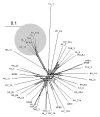Purifying selection and birth-and-death evolution in the class II hydrophobin gene families of the ascomycete Trichoderma/Hypocrea
- PMID: 18186925
- PMCID: PMC2253510
- DOI: 10.1186/1471-2148-8-4
Purifying selection and birth-and-death evolution in the class II hydrophobin gene families of the ascomycete Trichoderma/Hypocrea
Abstract
Background: Hydrophobins are proteins containing eight conserved cysteine residues that occur uniquely in mycelial fungi. Their main function is to confer hydrophobicity to fungal surfaces in contact with air or during attachment of hyphae to hydrophobic surfaces of hosts, symbiotic partners or themselves resulting in morphogenetic signals. Based on their hydropathy patterns and solubility characteristics, hydrophobins are divided into two classes (I and II), the latter being found only in ascomycetes.
Results: We have investigated the mechanisms driving the evolution of the class II hydrophobins in nine species of the mycoparasitic ascomycetous genus Trichoderma/Hypocrea, using three draft sequenced genomes (H. jecorina = T. reesei, H. atroviridis = T. atroviride; H. virens = T. virens) an additional 14,000 ESTs from six other Trichoderma spp. (T. asperellum, H. lixii = T. harzianum, T. aggressivum var. europeae, T. longibrachiatum, T. cf. viride). The former three contained six, ten and nine members, respectively. Ten is the highest number found in any ascomycete so far. All the hydrophobins we examined had the conserved four beta-strands/one helix structure, which is stabilized by four disulfide bonds. In addition, a small number of these hydrophobins (HFBs)contained an extended N-terminus rich in either proline and aspartate, or glycine-asparagine. Phylogenetic analysis reveals a mosaic of terminal clades containing duplicated genes and shows only three reasonably supported clades. Calculation of the ratio of differences in synonymous vs. non-synonymous nucleotide substitutions provides evidence for strong purifying selection (KS/Ka >> 1). A genome database search for class II HFBs from other ascomycetes retrieved a much smaller number of hydrophobins (2-4) from each species, and most were from Sordariomycetes. A combined phylogeny of these sequences with those of Trichoderma showed that the Trichoderma HFBs mostly formed their own clades, whereas those of other Sordariomycetes occurred in shared clades.
Conclusion: Our study shows that the genus Trichoderma/Hypocrea has a proliferated arsenal of class II hydrophobins which arose by birth-and-death evolution followed by purifying selection.
Figures







Similar articles
-
Novel hydrophobins from Trichoderma define a new hydrophobin subclass: protein properties, evolution, regulation and processing.J Mol Evol. 2011 Apr;72(4):339-51. doi: 10.1007/s00239-011-9438-3. Epub 2011 Mar 22. J Mol Evol. 2011. PMID: 21424760
-
Direct identification of hydrophobins and their processing in Trichoderma using intact-cell MALDI-TOF MS.FEBS J. 2007 Feb;274(3):841-52. doi: 10.1111/j.1742-4658.2007.05636.x. FEBS J. 2007. PMID: 17288563
-
Comparative genome sequence analysis underscores mycoparasitism as the ancestral life style of Trichoderma.Genome Biol. 2011;12(4):R40. doi: 10.1186/gb-2011-12-4-r40. Epub 2011 Apr 18. Genome Biol. 2011. PMID: 21501500 Free PMC article.
-
Recent advances and future prospects in peptaibiotics, hydrophobin, and mycotoxin research, and their importance for chemotaxonomy of Trichoderma and Hypocrea.Chem Biodivers. 2008 May;5(5):671-80. doi: 10.1002/cbdv.200890064. Chem Biodivers. 2008. PMID: 18493954 Review.
-
Fungal genus Hypocrea/Trichoderma: from barcodes to biodiversity.J Zhejiang Univ Sci B. 2008 Oct;9(10):753-63. doi: 10.1631/jzus.B0860015. J Zhejiang Univ Sci B. 2008. PMID: 18837102 Free PMC article. Review.
Cited by
-
Genome-wide analysis of cell wall-related genes in Tuber melanosporum.Curr Genet. 2012 Jun;58(3):165-77. doi: 10.1007/s00294-012-0374-6. Epub 2012 Apr 6. Curr Genet. 2012. PMID: 22481122
-
The Evolutionary and Functional Paradox of Cerato-platanins in Fungi.Appl Environ Microbiol. 2020 Jun 17;86(13):e00696-20. doi: 10.1128/AEM.00696-20. Print 2020 Jun 17. Appl Environ Microbiol. 2020. PMID: 32332135 Free PMC article.
-
Evolutionary analysis of hydrophobin gene family in two wood-degrading basidiomycetes, Phlebia brevispora and Heterobasidion annosum s.l.BMC Evol Biol. 2013 Nov 4;13:240. doi: 10.1186/1471-2148-13-240. BMC Evol Biol. 2013. PMID: 24188142 Free PMC article.
-
AlphaFold modeling uncovers global structural features of class I and class II fungal hydrophobins.Protein Sci. 2025 Sep;34(9):e70279. doi: 10.1002/pro.70279. Protein Sci. 2025. PMID: 40852847 Free PMC article.
-
Whole Genome Sequencing Reveals Major Deletions in the Genome of M7, a Gamma Ray-Induced Mutant of Trichoderma virens That Is Repressed in Conidiation, Secondary Metabolism, and Mycoparasitism.Front Microbiol. 2020 Jun 12;11:1030. doi: 10.3389/fmicb.2020.01030. eCollection 2020. Front Microbiol. 2020. PMID: 32595612 Free PMC article.
References
MeSH terms
Substances
LinkOut - more resources
Full Text Sources
Other Literature Sources
Miscellaneous

